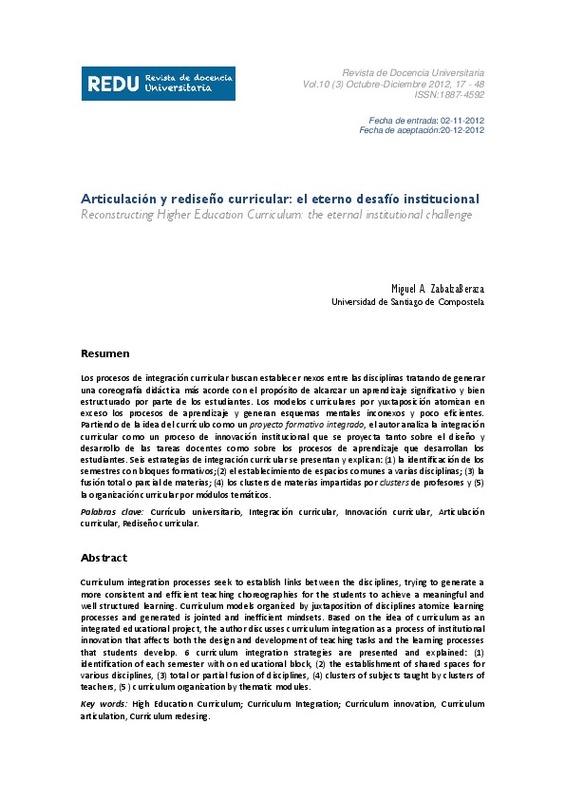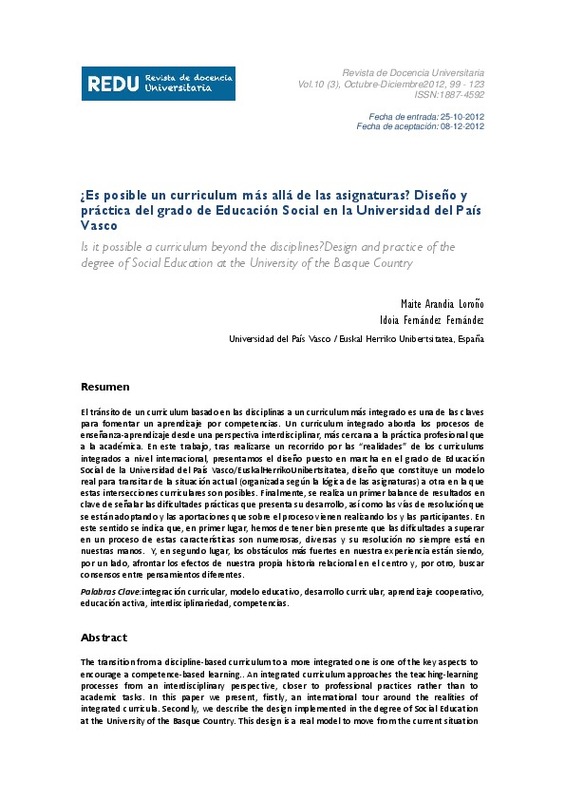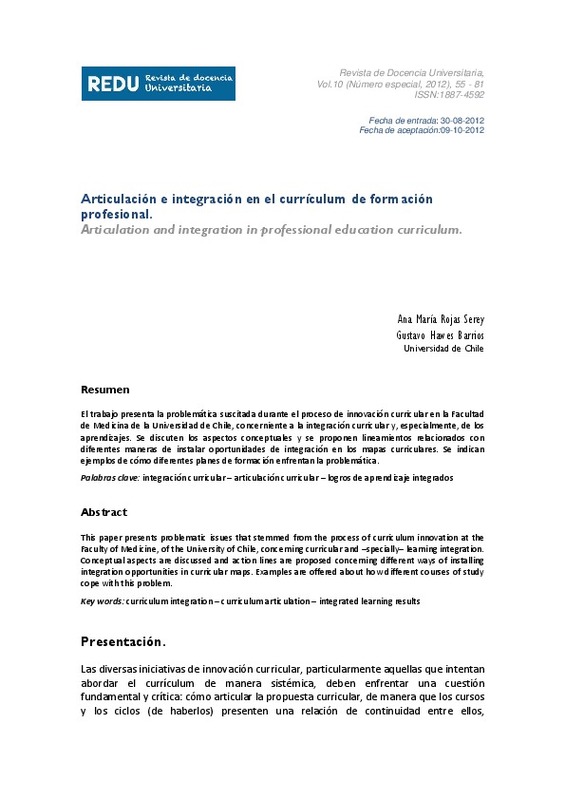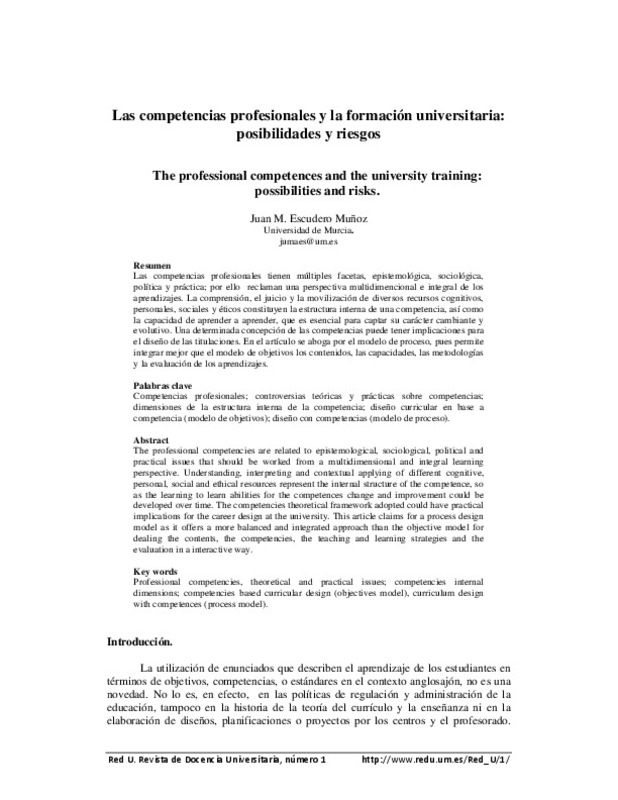Ashwin, P. (2009). Conceptualising Teaching and Learning Interactions in Researching Higher Education. En M. Tight et alii, The Routledge International Handbook of Higher Education. London: Routledge. Pg. 37‐46.
Beane, J.A. (2005). La integración del curriculum, el diseño del núcleo de la educación democrática. Madrid: Morata.
Berman, P. (1982). Educational Change: an implementation paradigm, en R. Lehming y M. Kane. Improving Schools: using what we know. Beverly Hills: Sage. Pg. 253‐ 286.
[+]
Ashwin, P. (2009). Conceptualising Teaching and Learning Interactions in Researching Higher Education. En M. Tight et alii, The Routledge International Handbook of Higher Education. London: Routledge. Pg. 37‐46.
Beane, J.A. (2005). La integración del curriculum, el diseño del núcleo de la educación democrática. Madrid: Morata.
Berman, P. (1982). Educational Change: an implementation paradigm, en R. Lehming y M. Kane. Improving Schools: using what we know. Beverly Hills: Sage. Pg. 253‐ 286.
Bricall, J.M. (coord.) (200 0). Universidad 2000. Madrid: CRUE (Conferencia de Rectores de las Universidades Españolas).
Brophy, J.E. y Good, Th.L. (1986). Teacher Behaviour and Student Achievement. En M.C. Wittrock. Handbook of Research onTeaching: third edition. New York: Mac Millan. Pag. 328‐375.
Chaves, A.L.; Hernández, D. y León, J. (2011). La integración curricular. Una experiencia en el primer nivel de diplomado de la carrera de Licenciatura en Pedagogía con énfasis en Educación Preescolar. Revista Electrónica Educare, XV (2), 63‐86.
Delors, J. et al. (1996). La Educación encierra un tesoro. Madrid. Unesco‐Santillana.
Escanero, J.F. (2007). Integración curricular. Educación Médica,10 (4), 217‐224.
Fullan, M.G. (1982). The Meaning of Educational Change. Toronto: OISE Press.
Glover, D.C.; Glenson, D.; Gough, G. y Johnson, M. (1998). The Meaning of Management : the development needs of middle manager in secondary schools", en Educational Management and Administration, 26 (3), 279‐292.
Haggis, T. (2009). Student Learning Research: a broader view. En M. Tight et alii, The Routledge International Handbook of Higher Education. London: Routledge. Pg. 23‐36.
Harden RM, Davis MH, Crosby JR. (1997). The new Dundee medical curriculum: a whole that is greater than the sum of the parts. Medical Education, 31:264‐71.
Harden, R.M. (2000). The integration ladder, a tool for curriculum planning and evaluation. Medical Education 2000, 34: 551‐557.
MacGregor, D. (1994). El lado humano de las organizaciones. Madrid: MacGraw‐Hill
Mello Carvalho, I. (1974). El proceso didáctico. Buenos Aires: Kapelusz
Menges, R. J. (1997). Fostering faculty motivation to teach. Approaches to faculty development, en J.L. Bess (Edit.): Teaching well and liking it. Motivating faculty to teach effectively. Baltimore: John Hopkins University Press, pp. 407‐423.
Oser, F.K. e Baeriswyl, F.J. (2001). Choreografies of Teaching: bridging instruction to teaching, en V. Richardson (Edit.): Handbook of Research on Teaching (4th Edition). Washington: AERA, ps. 1031‐1065.
Shulman, L.S. (1986). Paradigms and research programs in the Study of Teaching: a contemporary perspective. En M.C. Wittrock. Handbook of Research onTeaching: third edition. New York: Mac Millan. Pag. 3‐36
Villarini Jusino, A. (2000). El currículo orientado al desarrollo humano integral y al aprendizaje auténtico. Río Piedras, P.R: Organización para el Fomento del Desarrollo del Pensamiento, Inc.
Wittrock, M.C. (1986). Handbook of Research on Teaching: third edition. New York: Mac Millan
Zabalza Beraza, M.A. (2000). El papel de los departamentos universitarios en la mejora de la calidad de la docencia, en Revista Interuniversitaria de Formación del Profesorado, 38, p. 47‐66.
Zabalza, M.A. (2003). Competencias docentes del profesorado universitario. Madrid. Narcea.
Zabalza, M.A. y Zabalza Cerdeiriña, M.A. (2012). Innovación y cambio en las instituciones educativas. Rosario, Argentina: Homo Sapiens.
[-]











